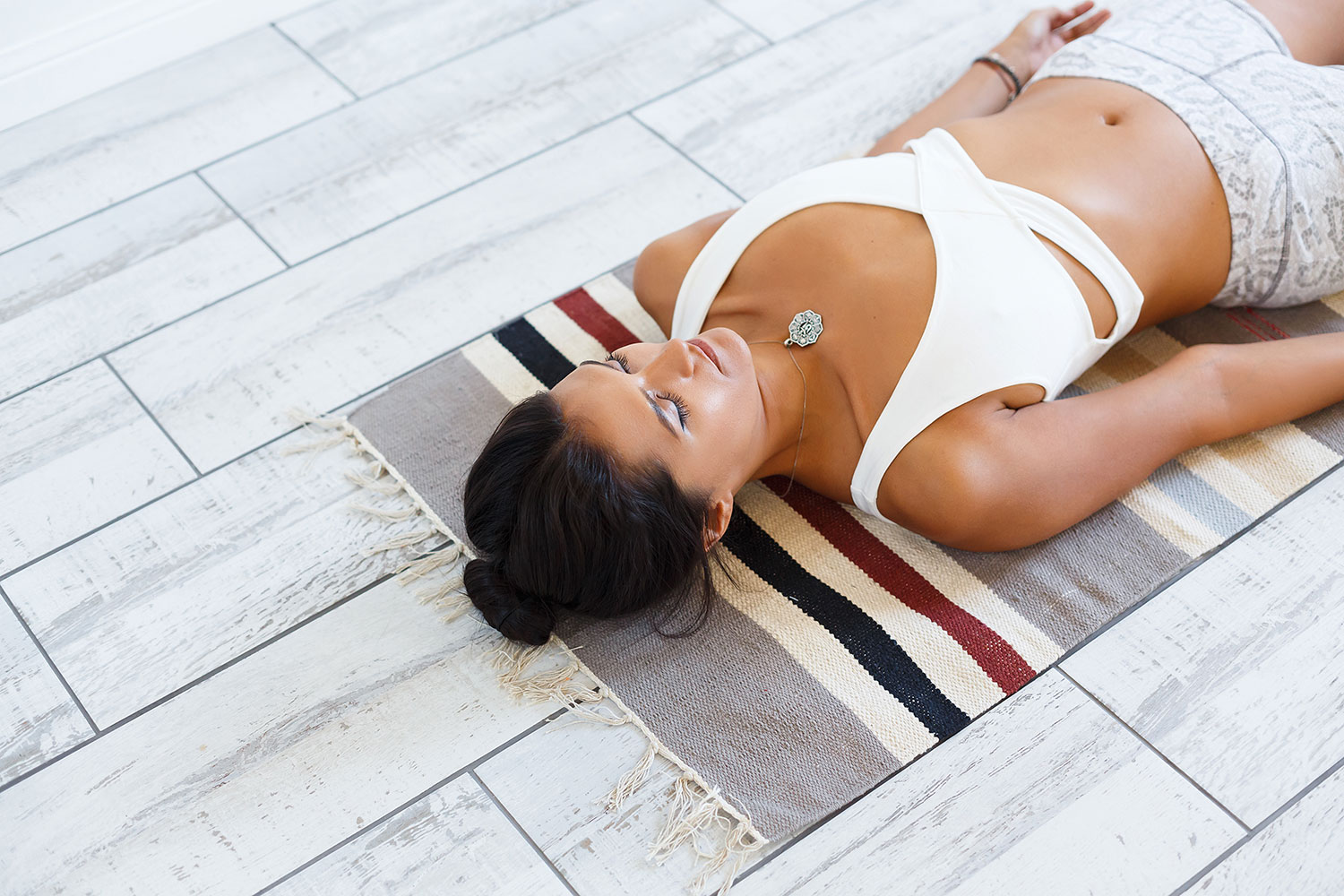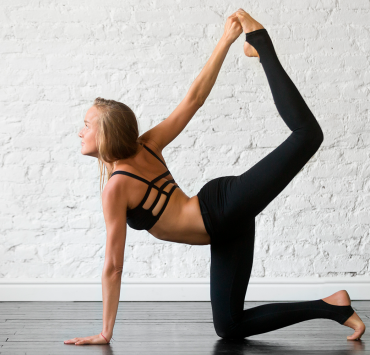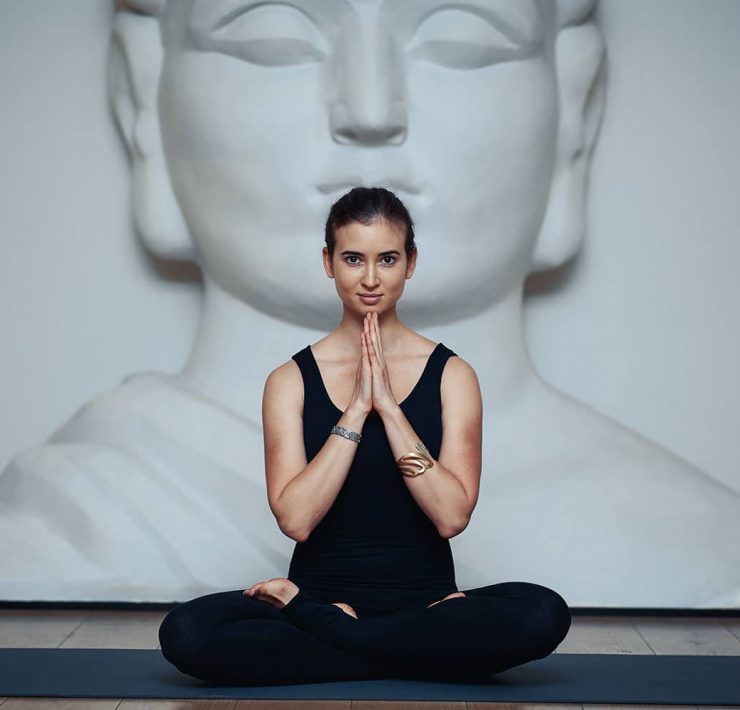
Catherine Perez is a celebrated yoga instructor in her home…
At the end of your yoga practice, it can be tempting and far too easy to just lie down in Shavasana and let your mind wander. But you’re missing out on one of the best postures of yoga – an opportunity to connect with yourself and find silence, stillness, and peace within.
Shavasana is physically, mentally, and spiritually beneficial. It’s often considered to be the most important pose in your practice – a common concept is that Shavasana prepares the body and mind for the final relaxation found in death.
Most yoga teachers move the class into Shavasana as a final posture. However it’s not uncommon for Shavasana to be used at the start of class, relaxing and preparing you for practice.
Typically, Shavasana is performed lying down on your back but other variations can include seated Shavasana which can be used in meditation. Yoga practices and sequences commonly use Shavasana to bring the body to rest. This includes Hatha, Iyengar, and Kundalini yoga, where Shavasana is used to open the lungs and to integrate changes in the body that are the result of a successful yoga practice.
History and Origins of Shavasana

Shavasana is a pose used in many different yoga types and practices. A Sanskrit word – shava means “corpse”, and asana is the “seat” or “posture”. The posture translates to mean “corpse pose”. We can find evidence of this asana being used as far back as the 15th century when Shavasana is described in the Hatha Yoga Pradipika, an ancient manual about the physical asanas of Hatha yoga:
“Lying full length on the back like a corpse is called Savasana. With this asana, tiredness caused by other asanas is eliminated; it also promotes calmness of the mind”.
The Steps of Shavasana

There’s more to Shavasana than just lying down on your mat with your arms at your side – the corpse pose isn’t easy for many yogis to fully get into after working through a flowing practice of sequences. Many students find themselves staring at the ceiling, unable to let go of thoughts and just open their mind. Others find themselves falling asleep when lying on their mat. Practice, practice, and more practice of Shavasana can help you make the most of this posture.
When you first start paying attention to your Shavasana posture, it may be difficult to relax. The intent is to relax each part of your body and mind, releasing the tension in your muscles and breathing deeply and freely.
Here are the steps for performing Shavasana:
- Lie down flat on your back on your mat. Make sure your head and neck are properly aligned. Your chin should never be higher than your forehead, otherwise the neck will be hyperextended which can cause discomfort and pain in the upper and lower back and spine. If needed, place a small pillow underneath your neck to achieve the correct head-neck alignment.
- Cover yourself with a blanket – your body will start to feel colder as you cool down after a yoga practice.
- Close your eyes and start to relax as you shift your body and find a comfortable position.
- Position your legs so they’re comfortably apart, allowing your knees and feet to relax. Let your toes fall to the outside without putting any pressure on the knees.
- Place your arms so they’re spread out a little from your body. Keep your palms open and facing upwards to allow energy to flow in.
- Focus on the different areas of your body, allowing each part to relax and release any tension. Start at the bottom with your feet, relaxing each body part as you move up to your head. Shift your body as needed to find the best position for your Shavasana.
- Breathe deeply and fully, allowing your breathing to become more relaxed as you fall deeper into the pose. With each breath in, your body is energized with life. With each breath out, you become more relaxed.
- Let go of “outside” thoughts – there is no other place you need to be or anything else that you need to be doing at this time. Allow yourself to be in the moment, inside your breath and body. Let go and surrender to Shavasana.
- Stay in Shavasana for at least 10 to 15 minutes, keeping your eyes closed.
- When ready to come out of Shavasana, still keeping your eyes closed, start to wiggle your fingers and toes. Roll your shoulders from side to side, then your hips.
- Slowly roll over onto the right side of your body. Stay here in this position for a minute to adjust. Using your right hand for support, push yourself up into a seated position, sitting in Sukhasana (Easy Pose).
- Still with your eyes closed, breathe deeply and become aware of the room around you. Slowly open your eyes and feel your full presence in the room.
Tips for Shavasana
If you find yourself starting to fall asleep during Shavasana, focus on your breathing – breathe deeper and faster to bring yourself into a higher state of “wakefulness” without completely releasing the relaxation that you’re feeling.
If you find it difficult to relax and your mind is thinking about life off the mat, consider counting to 108 during Shavasana. 108 is a sacred number in yoga and Hindu – count to 108 and take note of your depth into Shavasana. If you’re still not as calm as you want to be, continue to count in cycles to 108. If this is all you do during Shavasana, it’s okay. Your body and mind are still practicing the pose – deeper relaxation without counting will come with more practice.
Light will stimulate your senses, so practice Shavasana in darkness. Most yoga teachers will dim the lights during Shavasana, but even then, this may not be enough. Use an eye pillow to achieve total darkness.
Depending on the class, some teachers will play relaxing music during Shavasana – consider doing this at home during your own practice if you find it helps you feel more peaceful.
Deepening Your Shavasana

There are ways to refine and deepen your Shavasana practice so that you become more conscious of the pose and its benefits. One of the ways to do this is by using props to support different parts of the body.
Props to refine Shavasana
Using props can refine your Shavasana experience, helping you to focus on certain parts of the body. Props can be a bolster, rolled up blanket, or yoga blocks.
- While lying down, place a prop underneath your calves to relax the legs. This is a good way to ease calf and leg muscles after yoga practice or exercise. It’s also beneficial if you’ve been standing or sitting too long. When your legs are slightly elevated during Shavasana, it can also help to release tension throughout the back muscles and improve circulation. Allow yourself to breathe deeply into the pose.
- Place a bolster or rolled blanket underneath your back, directly along the spine. The bolster should be long enough to support your head and full length of the back. Lying in Shavasana in this position helps to expand and open up your chest while relaxing and releasing the shoulders. This open pose is good to increase the natural flow of your breathing. This deepening of Shavasana is good for anyone who is feeling tension in the upper body or if your energy is low.
- Consider using an eye pillow to bring you even deeper into Shavasana. The gentle pressure around your eyes can help to relax your temples, eyebrows, cheekbones, and neck which can in turn help to lower your heart rate.
- As you lie down on your mat and prepare for Shavasana, take a minute to scan your body. Tense and release first the muscles in your feet, working up through your body. Breathe deeply and each time that you exhale allow your body to sink even deeper into the mat. Are there any areas that feel uncomfortable? Use props to fully relax and get comfortable. This may mean a prop under your knees or a thinly rolled up blanket under your neck to keep your neck and back in alignment. When you’re fully relaxed, you’re ready for Shavasana.
In traditional yoga practices, Shavasana will last for at least 30 minutes. This allows the mind and body to move into a complete state of relaxation. Here in the west, Shavasana varies in length but is usually performed for a shorter length of time. Perhaps this is due to the hectic pace in which contemporary society moves. Practice Shavasana for a full 30 minutes to see how deeply you can relax and fall into a state of peace.
Benefits of Shavasana

Shavasana has many benefits, some which are very subtle and only fully recognized over time, as you make Shavasana a regular part of your practice. Benefits are physical, mental, and spiritual – as you move into moments of full relaxation you expand your consciousness and enter into a state of harmony with all three.
Physical benefits
The physical benefits of Shavasana are many:
- Reduce anxiety and stress. Lowering your stress can have a positive impact on a variety of health issues that are stress-related such as diabetes, cancer, and heart disease.
- Help with sleep issues. If you have insomnia or wake frequently during the night, Shavasana is ideal to practice before bed. The pose helps you enter a state of calm and conscious peacefulness which can help you sleep better.
- Natural regulation of the immune and digestive systems. This is done as Shavasana takes you from the sympathetic nervous system of the body, known as “flight or fight”, to the parasympathetic, where your body is able to rest and release.
- Lower blood pressure. Shavasana can help to lower your blood pressure as the sympathetic system becomes more tranquil.
Mental boosts of Shavasana
Yoga is a combination of prana and asana, where breath and physical poses come together. During Shavasana, the asana is relaxed with no need to use muscles or physical energy to hold the pose. Shavasana is more about prana, as your breath flows through your body to help you actively relax and find harmony within.
Shavasana can be very helpful after a fast-paced yoga practice, helping you to feel renewed and rejuvenated. Even a slow-paced practice benefits from Shavasana as you learn how to “do nothing”. This nothingness releases the tension that you’ve built up within your body as you moved through the physical asanas in your practice.
The spiritual, sacred side of Shavasana
As you begin Shavasana, you’re highly aware of your body – the way it feels as you lie down and prepare for Shavasana. As prana flows through your body and you begin to relax, you can enter into a more spiritual awareness of your mind, connecting with inner energy and spirit. The limits of your body can start to fade away as you become a more conscious being.
Using Shavasana in Meditation

Shavasana can be used in meditation by deepening your awareness. Meditation can often make you drowsy – practicing Shavasana lying down teaches you how to relax while still being alert.
Find a yoga class that uses a guided meditation during Shavasana. If practicing at home, you can use an audio guided mediation to get the same results. A guided meditation is extremely refreshing and can bring you into an intense level of relaxation.
Another way to incorporate meditation with Shavasana is to first perform Shavasana lying down for 10 to 20 minutes. Upon sitting and coming out of Shavasana, you can enter into your meditation. The benefit here is that you’re already in a relaxed state, making it easier to meditate and focus your intent.
Connecting With Shavasana

In life we become so adept at using our mind and body to reach our goals. With Shavasana we need to become just as skilled at releasing and relaxing. This helps us to achieve the many benefits that this pose can bring not just to our yoga practice but to every moment of our day.
It takes practice to let go of the concept that in order for “things” to happen, there must be action. Shavasana helps you reach into a deeper part of yourself and allow things to happen at their own pace and in their own time. Use Shavasana as a way to connect with the true self within as you experience relief, silence, and stillness.
What's Your Reaction?
Catherine Perez is a celebrated yoga instructor in her home state of Connecticut, and she also happens to have a marvelous way with words. Her mindful writing technique is easy to digest and gives readers a unique opportunity to learn from a seasoned yogi.














